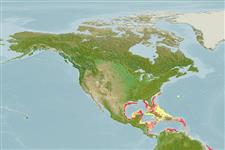Teleostei (teleosts) >
Gobiiformes (Gobies) >
Gobiidae (Gobies) > Gobiinae
Etymology: Varicus: Latin, varix = dilated vein (Ref. 45335); marilynae: Named after Marilyn Gilmore (wife of author).
Eponymy: Marilyn Gilmore, wife of the author Dr R Grant Gilmore (q.v.), whose etymology stated she “…has aided me considerably in my ichthyological studies.” (Ref. 128868), visit book page.
Environment: milieu / climate zone / depth range / distribution range
Ecology
Marine; demersal; depth range 61 - 91 m (Ref. 39827). Subtropical
Western Central Atlantic: continental waters off the east and west coasts of Florida.
Size / Weight / Age
Maturity: Lm ? range ? - ? cm
Max length : 2.5 cm SL male/unsexed; (Ref. 39827); 1.8 cm SL (female)
Distinguished by the following characteristics: unbranched pelvic rays; first four pelvic rays with expanded tips; rudimentary fifth pelvic ray; bilobed tongue; scales under first dorsal fin ctenoid (Ref. 92840).
Inhabit open sand or shell-hash bottom with scattered small rocks (Ref. 39827).
Life cycle and mating behavior
Maturity | Reproduction | Spawning | Eggs | Fecundity | Larvae
Robins, C.R., R.M. Bailey, C.E. Bond, J.R. Brooker, E.A. Lachner, R.N. Lea and W.B. Scott, 1991. Common and scientific names of fishes from the United States and Canada. Am. Fish. Soc. Spec. Publ. (20):183 p. (Ref. 3814)
IUCN Red List Status (Ref. 130435: Version 2024-2)
Threat to humans
Harmless
Human uses
Tools
Special reports
Download XML
Internet sources
Estimates based on models
Preferred temperature (Ref.
123201): 17.1 - 25.7, mean 22.4 °C (based on 9 cells).
Phylogenetic diversity index (Ref.
82804): PD
50 = 0.7500 [Uniqueness, from 0.5 = low to 2.0 = high].
Bayesian length-weight: a=0.00955 (0.00355 - 0.02566), b=3.03 (2.80 - 3.26), in cm total length, based on LWR estimates for this (Sub)family-body shape (Ref.
93245).
Trophic level (Ref.
69278): 3.1 ±0.3 se; based on size and trophs of closest relatives
Resilience (Ref.
120179): High, minimum population doubling time less than 15 months (Preliminary K or Fecundity.).
Fishing Vulnerability (Ref.
59153): Low vulnerability (10 of 100).
